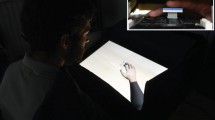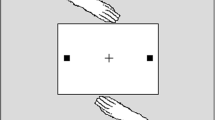Abstract
Recent behavioural research has investigated whether viewing someone perform an action results in activation of that action by the observer. Postulated empirical support for this ‘ideo-motor (IM) conjecture’ typically rests upon two types of experimental paradigm (reaction time and movement tracking tasks). These paradigms purport to show movement facilitation when compatible movements are observed and vice versa, but only for biological stimuli. Unfortunately, these paradigms often contain confounding (and unavoidable) generic stimulus–response compatibility effects that are not restricted to observed human movement. The current study demonstrates in three experiments that equivalent compatibility effects can be produced by non-biological stimuli. These results suggest that existing empirical paradigms may not, and perhaps cannot, support the IM-conjecture.





Similar content being viewed by others
Notes
At the suggestion of a reviewer, we checked to see whether the order had any effect on the results. There was neither a main effect nor any interactions involving order (all P > 0.65) suggesting that the analysis reported below was not influenced by the order manipulation.
References
Aicken MD, Wilson AD, Williams JHG, Mon-Williams M (2007) Methodological issues in measures of imitative reaction times. Brain Cogn 63:304–308
Brass M, Heyes C (2005) Imitation: is cognitive neuroscience solving the correspondence problem. Trends Cogn Sci 9:489–495
Brass M, Bekkering H, Prinz W (2001) Movement observation affects movement execution in a simple response task. Acta Psychol 106:3–22
Cohen RG, Rosenbaum DA (2004) Where grasps are made reveals how grasps are planned: generation and recall of motor plans. Exp Brain Res 157:486–495
De Jong R (1995) Strategical determinants of compatibility effects with task incertainty. Acta Psychol 88:187–207
Fitts PM, Seeger CM (1953) S-R compatibility: spatial characteristics of stimulus and response codes. J Exp Psychol 46:199–210
Gallese V, Goldman A (1998) Mirror neurons and the simulation theory of mind-reading. Trends Cogn Sci 12:493–501
Gibson JJ (1977) The theory of affordances. In: Shaw RE, Bransford J (eds) Perceiving, acting, and knowing. Erlbaum, Hillsdale, NJ
Hommel B (1996) S-R compatibility effects without response uncertainty. Q J Exp Psychol 49(3):546–571
Iacoboni M, Koski LM, Brass M, Bekkering H, Woods RP, Dubeau MC, Mazziotta JC, Rizzolatti G (2001) Reafferent copies of imitated actions in the right superior temporal cortex. Proc Natl Acad Sci USA 98:13995–13999
James W (1890) The principles of psychology. Macmillan, London
Kilner JM, Paulignan Y, Blakemore SJ (2003) An interference effect of observed biological movement on action. Curr Biol 13:522–525
Miall CR, Imamizu H, Miyauchi S (2000) Activation of the cerebellum in co-ordinated eye and hand tracking movements: an fMRI study. Exp Brain Res 135:1432–11106
Meltzoff AN, Decety J (2003) What imitation tells us about social cognition: a rapprochement between developmental psychology and cognitive neuroscience. Philos Trans R Soc Lond 358:491–500
Press C, Bird G, Flach R, Heyes C (2005) Robotic movement elicits automatic imitation. Cogn Brain Res 25:632–640
Ratcliff R (1979) Group reaction time distributions and an analysis of distribution statistics. Psychol Bull 86:446–461
Rizzolatti G (2005) The mirror neuron system and its function in humans. Anat Embryol 210:419–421
Rizzolatti G, Fogassi L, Gallese V (2001) Neurophysiological mechanisms underlying the understanding and imitation of action. Nat Rev Neurosci 2:661–670
Sebanz N, Knoblich G, Prinz W (2003) Representing others’ actions: just like one’s own? Cognition 88:B11–B21
Shaffer LH (1965) Choice reaction with variable S-R mapping. J Exp Psychol 70:284–288
Sommerville JA, Decety J (2006) Weaving the fabric of social interaction: articulating developmental psychology and cognitive neuroscience in the domain of motor cognition. Psychon Bull Rev 13(2):179–200
Stock A, Stock C (2004) A short history of ideo-motor action. Psychol Res 68:176–188
Stoffels EJ (1996) On stage robustness and response selection: further evidence. Acta Psychol 91:67–88
van Donkelaar P, Lee RG, Gellman RS (1994) The contribution of retinal and extraretinal signals to manual tracking movements. Exp Brain Res 99:155–163
Vu KPL, Proctor RW (2004) Mixing compatible and incompatible mappings: elimination, reduction, and enhancement of spatial compatibility effects. Q J Exp Psychol A: Hum Exp Psychol 57:539–556
Wilson M, Knoblich G (2005) The case for motor involvement in perceiving conspecifics. Psychol Bull 131(3):460–473
Williams JHG, Whiten A, Waiter GD, Pechey S, Perrett DI (2007) Cortical and subcortical mechanisms at the core of imitation. Soc Neuro 2(1):66–78
Wolpert D, Ghahramani Z, Flanagan R (2001) Perspectives and problems in motor learning. Trends Cogn Sci 5:487–494
Author information
Authors and Affiliations
Corresponding author
Rights and permissions
About this article
Cite this article
Jansson, E., Wilson, A.D., Williams, J.H.G. et al. Methodological problems undermine tests of the ideo-motor conjecture. Exp Brain Res 182, 549–558 (2007). https://doi.org/10.1007/s00221-007-1013-1
Received:
Accepted:
Published:
Issue Date:
DOI: https://doi.org/10.1007/s00221-007-1013-1




